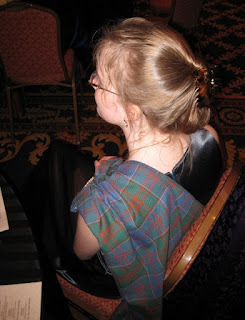 Saturday night's Scottish shindig shepherded us into the world of bagpipes, haggis, and tatties and neeps.
Saturday night's Scottish shindig shepherded us into the world of bagpipes, haggis, and tatties and neeps.After driving frantically to Emma's Scottish Country Dance practices across town, searching resale/thrift stores for the perfect gown, painting shoes, and spinning endless jewelry displays hunting earrings that would complement the dress, the big night finally arrived.
A stunning display of tartan flags, the poles arranged upright in a circle, greeted us as we entered the Marriott Westchase. The low, reedy hum of bagpipes called to us from down the hall, filling us with anticipation and preparing us for the lively music that would soon accompany the dancers as they performed for the Heather and Thistle Society.
 Young ladies of Scottish Country Dance. Photo by Tiffany Clede
Young ladies of Scottish Country Dance. Photo by Tiffany Clede
While Emma changed into her dance shoes, I peeked into the ballroom to see men in kilts and many of the women in simple gowns with tartan sashes worn over the shoulder, secured with a lovely "medallion" of the same fabric. Some added a pin to the center of the medallion, completing an interesting and elegant costume. Wearing the plaid sash. Photo by Tiffany Clede
Wearing the plaid sash. Photo by Tiffany Clede
Meanwhile, the dance teacher, Mooneyeen Weiss, who prefers to be called "Moon", supervised a walk-through of the dances her students were to perform.

 Emma and Dominic dancing the elegant Deeside Wanderer, which is done in a square formation.
Emma and Dominic dancing the elegant Deeside Wanderer, which is done in a square formation.
 Dancing the fast-paced Tomalina, which uses a figure with double-double triangles.Photo by Tiffany Clede
Dancing the fast-paced Tomalina, which uses a figure with double-double triangles.Photo by Tiffany Clede
Our group danced well; each dance ended to fabulous applause. Now they were free to leave and return at 10 p.m. for the Ceilidh dancing.
So while the Robert Burns Supper ticket holders dined on the haggis, the national dish of Scotland--which according to About.com consists of cooked minced sheep’s offal mixed with suet, oatmeal, and seasoning all cunningly encased in the sheep’s stomach--we took the opportunity to sup at Phoenicia Specialty Foods. It is actually a grocery store with a fabulous deli and bakery. The store features groceries imported from around the world; the deli specializes in Mediterranean and Middle Eastern fare. (I made a mental note of their meat pies for future picnics.) Just the name of my meal tantalized me: Chicken Shawarma. The dancers enjoy a silly moment as they return to their cars.
The dancers enjoy a silly moment as they return to their cars.
Back at the Marriott, the crowd had thinned out considerably. Some of us moms found an empty table in the ballroom where we could survey the Ceilidh dancing in comfort and sample some abandoned haggis and tatties (potatoes) and nips (turnips). However, when one mom said that her bite of haggis reminded her of dog food, I declined a sample.
Though the girls enjoyed the Ceilidh dancing, they suffered from a lack of male partners and often had to dance with each other. Two of our young men could not resist the temptation of a good game of chess, but there were men aplenty who could have given our eager-to-dance young ladies the pleasure but did not. Maybe their haggis had not settled well or their kilts were out of kilter.
The evening ended at midnight with a dance done to "Auld Lang Syne" but not before a waltz allowed Emma and Thomas to practice their Irish waltzing skills that they have been learning since last fall. They danced beautifully, and I heard that Moon was "astounded" when she saw them.
Emma and I made it home at 1:30 a.m., exhausted but ready to do it all over again if the opportunity arises.
AN EXPLANATION OF THE BURNS SUPPER TRADITION FROM THE HEATHER AND THISTLE SOCIETY:
Every year the Heather and Thistle Society have the Annual Burns Supper where several hundred people gather to celebrate the contribution Robert Burns made to the world.
Burns Suppers have been part of Scottish culture for about 200 years as a means of commemorating our best loved bard (a tribal poet-singer skilled in composing and reciting verses on heroes and their deeds). And when Burns immortalized haggis in verse he created a central link that is maintained to this day.
The ritual was started by close friends of Robert Burns a few years after his death in 1796 as a tribute to his memory. The basic format for the evening has remained unchanged since that time and begins when the chairman invites the company to receive the haggis.
3 comments:
Emma is lovely!
Thanks, Cay!
It looks like it was quite a nice time. Emma looked very pretty.
Post a Comment